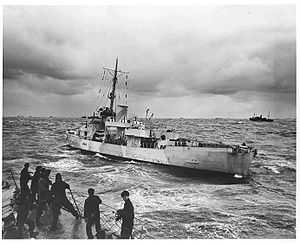USCGC Spencer (WPG-36)
 USCGC Spencer during WWII | |
| Career (US) | |
|---|---|
| Name: | USCGC Spencer |
| Builder: | New York Navy Yard |
| Laid down: | 11 September 1935 |
| Launched: | 6 January 1937 |
| Commissioned: | 1 March 1937 |
| Decommissioned: | 23 January 1974 |
| Fate: | Sold for scrapping on 8 October 1981 to North American Smelting Co. |
| General characteristics | |
| Class & type: | Treasury-class cutter |
| Displacement: | 2,216 long tons (2,252 t; 2,482 short tons) |
| Length: | 327 ft (99.67 m)o/a |
| Beam: | 41 ft (12.50 m) |
| Draught: | 12.5 ft (3.81 m) |
| Propulsion: |
|
| Speed: | 20.5 knots (38.0 km/h) |
| Range: | 12,300 nautical miles (22,780 km) at 11 knots (20.4 km/h) |
| Capacity: | 135,180 US gallons (511,712 L) |
| Complement: |
|
| Sensors and processing systems: |
|
| Armament: |
|
| Aircraft carried: | 1 Grumman JF-2 Duck or Curtiss SOC-4 |
| Wikimedia Commons has media related to USCGC Spencer (WPG-36). |
USCGC Spencer (WPG-36) was a Treasury-class cutter of the United States Coast Guard that served during World War II.[1]
Early career and World War II
Commissioned in 1937, she was first used as a search and rescue unit off Alaska's fishing grounds. When the United States entered World War II the Coast Guard temporarily became part of the United States Navy. Spencer saw service in the Pacific War. During the Battle of Atlantic she acted as a convoy escort, hunting German U-boats, and was responsible for sinking U-175 in 1943.
Convoys escorted
| Convoy | Escort Group | Dates | Notes |
|---|---|---|---|
| ON 67 | 26-28 Feb 1942[2] | from Iceland to Newfoundland | |
| HX 178 | MOEF group A3 | 6-16 March 1942[3] | from Newfoundland to Iceland |
| ON 79 | 24-31 March 1942[2] | Iceland shuttle | |
| HX 185 | MOEF group A3 | 18-26 April 1942[3] | from Newfoundland to Northern Ireland |
| ON 92 | MOEF group A3 | 7-18 May 1942[2] | from Northern Ireland to Newfoundland |
| HX 196 | MOEF group A3 | 2-10 July 1942[3] | from Newfoundland to Northern Ireland |
| ON 114 | MOEF group A3 | 20-30 July 1942[2] | from Northern Ireland to Newfoundland |
| SC 95 | MOEF group A3 | 8-18 Aug 1942[4] | from Newfoundland to Northern Ireland |
| ON 125 | MOEF group A3 | 29 Aug-7 Sept 1942[2] | from Northern Ireland to Newfoundland |
| SC 100 | MOEF group A3 | 16-27 Sept 1942[4] | from Newfoundland to Northern Ireland |
| ON 135 | MOEF group A3 | 3-14 Oct 1942[2] | from Northern Ireland to Newfoundland |
| SC 111 | MOEF group A3 | 1-16 Dec 1942[4] | from Newfoundland to Northern Ireland |
| ON 156 | MOEF group A3 | 24 Dec 1942-8 Jan 1943[4] | from Northern Ireland to Newfoundland |
| HX 223 | MOEF group A3 | 19-late Jan 1943[3] | from Newfoundland to Northern Ireland |
| ON 166 | MOEF group A3 | 12-25 Feb 1943[2] | from Northern Ireland to Newfoundland |
| SC 121 | MOEF group A3 | 3-12 March 1943[2] | from Northern Ireland to Newfoundland |
| ON 175 | MOEF group A3 | 25 March-7 April 1943[4] | from Northern Ireland to Newfoundland |
| HX 233 | MOEF group A3 | 12-20 April 1943[3] | from Newfoundland to Northern Ireland |
Spencer was assigned to the US Navy's Seventh Fleet, in the Pacific in late 1944, where she served as a Communications Command Ship. There she was credited with taking part in numerous amphibious assaults including Luzon and Palawan in the Philippines Campaign.
Post-war career
After the war Spencer returned to her Coast Guard duties, serving in the Atlantic Ocean. Here she provided navigational assistance for the fledgling Trans-Atlantic air industry and acted as a search and rescue platform both ships and aeroplanes. She returned to combat duty off the Vietnam coast in January 1969. For ten months she carried out surveillance to prevent troops and supplies from getting into South Vietnam. Spencer returned to the United States in November 1969 and continued her peace-time mission of ocean station keeping. The Spencer served for over 37 years and when decommissioned in 1974 she was the most decorated cutter in the Coast Guard's fleet. Her last voyage was from New York City to the United States Coast Guard Yard, Curtis Bay on 15 January 1974. Onboard her for this voyage were 24 of her World War II crew. She was decommissioned on 23 January 1974. She served as an engineering training ship with students using her steam propulsion plant until 15 December 1980. She was then sold to the North American Smelting Company and scrapped.
Awards
- 1 Presidential Unit Citation
- 1 American Campaign Medal
- 1 WWII Victory Medal
- 1 China Service Medal
- 2 National Defense Service Medals
- 1 Philippine Presidential Unit Citation
- 3 Vietnam Service Medals
- 1 Republic of Vietnam Armed Forces Medal
- 1 Republic of Vietnam Campaign Medal
- 1 American Defense Service Medal
- 5 European-African-Middle Eastern Campaign Medals
- 5 Asiatic-Pacific Campaign Medals
- 1 Navy Occupation Service Medal
- 3 Philippine Liberation Ribbons
- 1 Republic of Vietnam Meritorious Unit Citation with Gallantry Cross with Palm
References
- ↑ "USCG Spencer". U.S. Coast Guard Cutter History. United States CoastGuard. Retrieved 2012-12-12.
- ↑ 2.0 2.1 2.2 2.3 2.4 2.5 2.6 2.7 "ON convoys". Andrew Hague Convoy Database. Retrieved 2011-06-19.
- ↑ 3.0 3.1 3.2 3.3 3.4 "HX convoys". Andrew Hague Convoy Database. Retrieved 2011-06-19.
- ↑ 4.0 4.1 4.2 4.3 4.4 "SC convoys". Andrew Hague Convoy Database. Retrieved 2011-06-21.